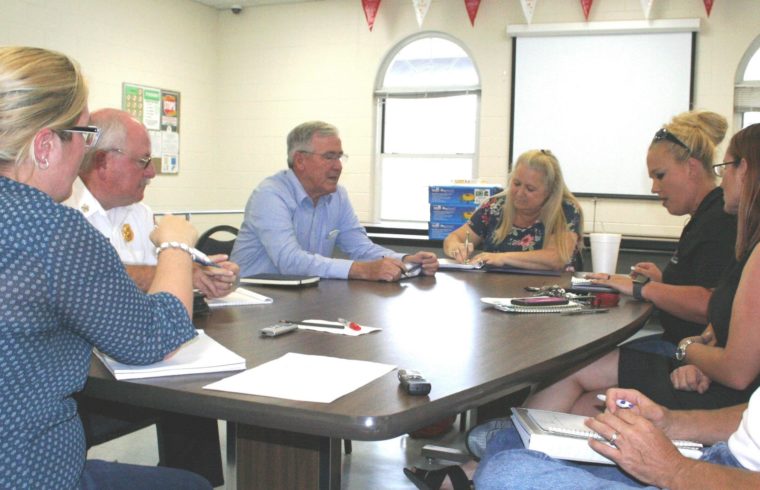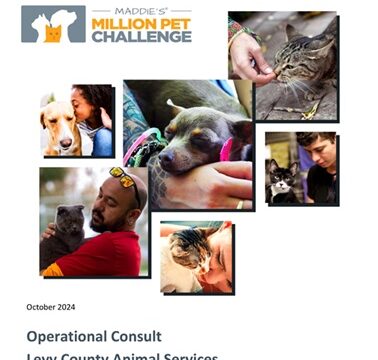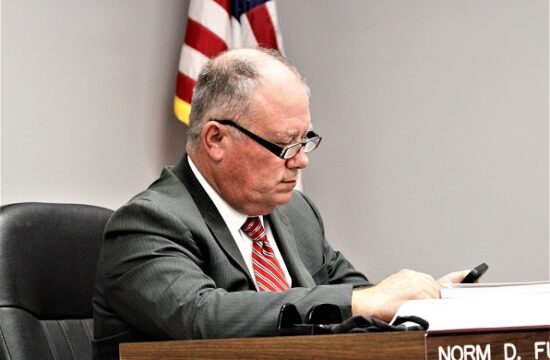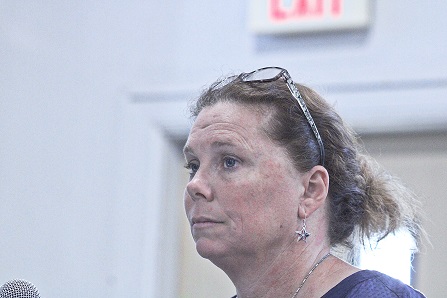County and union officials discuss the International Association of Firefighters contract. Starting on the left and going clockwise, Alesha Renaudo of the Department of Public Safety, Public Safety Director Mitch Harrell, County Coordinator Wilbur Dean, County Human Resources Director Jacqueline Martin, Union President Katy Yanok, paramedic Vicki Constable and Union Vice President Chris Castleberry.
By Terry Witt – Spotlight Senior Reporter
Levy County emergency medical service crews said Wednesday the Mercedes Sprinter ambulances they operate every day are so overweight, unstable and dangerous that paramedics and EMTs should be given hazardous pay until the problems are fixed.
The proposal was part of the opening round of negotiations between the International Association of Firefighters Local 4069 representing ambulance crews and firefighters and the county administrators representing the Levy County Commission and its Department of Public Safety.
Neither side expected to reach a final decision on the issues discussed at the bargaining table, but County Coordinator Wilbur Dean said he suspects the hazardous pay would be a non-starter with commissioners. He tossed out the possibility that the county might consider purchasing lower cost ambulances as a compromise to giving hazardous pay, though he made no promises on how many could be purchased or if the board would go along with the idea.
“Just to go ahead and address the issue of the hazardous pay, I realize this is not mine to make totally. I’m just going to say that I think that’s going to be probably a non-starter and if it is, there are other ways for us to get to where we need to be on that, and part of it is if we take a punt and buy different ambulances to get where we are; the board would probably have to do economy line to be able to afford to get there in one swoop to that place, and I don’t think any of us plan to get there that way.”
Katy Yanok, president of IAFF Local 4069, said the ultimate goal and primary objective of the union is to ensure the safety of the passengers and crews riding aboard ambulances and not necessarily to ride in shiny new top of the line ambulance models that cost more. She left open the possibility that the union might be receptive to Dean’s proposal on replacing hazardous pay with safer and less costly ambulances.
“They just mentioned having a baseline economy ambulance instead of hazardous pay. We can want the top of the line pretty shiny new trucks but at the end of the day we prefer safety and less risk of liability for our collective bargaining unit members than having top of the line pretty shiny new trucks,” Yanok said after the negotiating session.
Compensation Offers
The union is requesting an 8 percent across the board pay raise and an additional but temporary 25 percent raise for hazardous pay until the high risk issues with the Sprinter ambulances are corrected.
Dean countered by saying the county is interested in capping the amount of money it pays for employee health insurance but would consider giving employees a pay raise. The percentage of the pay raise hasn’t been determined.
“When we figure out the cost of an employee policy, the board would like to know pretty well a fixed number every year going into it,” Dean said. “In the future they will be able to look at what they have to work with as far as raises and incentives.”
From the union’s perspective, Yanok said capping the amount commissioners pay for an employee’s health insurance policy would mean employees would pick up all the future increases in health insurance costs. She said that would be a burden for employees. Health insurance costs rise every year. Employees lost a big benefit when commissioners stopped paying for employee family coverage.
The county has received bids from health insurance companies and Dean said he expects the board to review the bids at the July 16 county commission meeting.
Negotiations will resume on July 29. After the bargaining session, county commissioners will meet in executive session to discuss strategy. Such meetings are often called “shade meetings” because the board isn’t required to meet in the sunshine. The meetings are closed to the public and media.
Overweight Ambulances, Explosive Airbags
Yanok said all the Sprinter ambulances are several hundred pounds overweight which makes them more difficult to stop, prone to brake-failure and more susceptible to dangerous rollovers when ambulance paramedics and Emergency Medical Technicians are working on patients in the back. Yanok said Sprinters are also equipped with air bag inflators that have the potential to explode with excessive force and deliver shrapnel into the cab. She said the airbags are part of a national recall. The explosion of the airbags can injure or kill people in the ambulance cab.
She said the manufacturer has replaced the airbags protecting EMTs driving the Sprinters but there appears to be no solution in sight for correcting the airbags on the passenger side of the ambulance cab. Yanok said the county has directed paramedics not to carry civilians in the cab of ambulances but she said there are “extenuating circumstances” where it’s unavoidable. She said if the ambulance crew is working on a critically ill pediatric patient (a child) for example, and there’s no seat-belted space in the back of the ambulance for the parent, or the parent is so emotional that paramedics and EMTs are having trouble working on the child and the parent would have to move to the cab.
“If that’s your child, are you going to send them to the hospital with strangers without you accompanying them?” she said.
Yanok said Levy County is the only county in this area operating Sprinter ambulances, which have a narrow box and are taller than standard ambulances. Former Public Safety Director David Knowles changed the entire fleet of ambulances from wide-bodied models to the narrow Sprinters. Yanok said she realizes neither Dean nor her new boss, Public Safety Director Mitch Harrell were working for the county when Knowles made the Sprinter purchases. But she said that doesn’t change the fact that Sprinters are dangerous for ambulance crews and patients.
“You can’t put a price on someone’s life, but you are subjecting them (ambulance crews) to unnecessary hazards that they would not be subjected to anywhere else to my knowledge – not one unnecessary hazard but two,” she said.
The hazardous pay is justified, she said.
Dean said there is a limit to how much the county commission can spend. He said hazardous pay probably won’t find favor with the county commission.
“Economically there are points where the board has limitations and when you put 25 percent hazardous pay in there, they are going to look for different alternative,” Dean said.
——
Negotiations Meeting of International Association of Firefighters Local 4069 and County Administrators July 2, 2019













